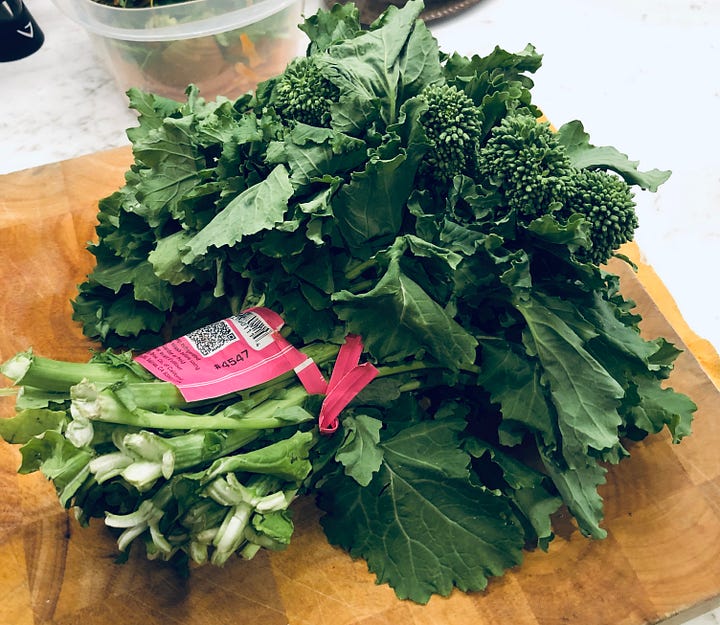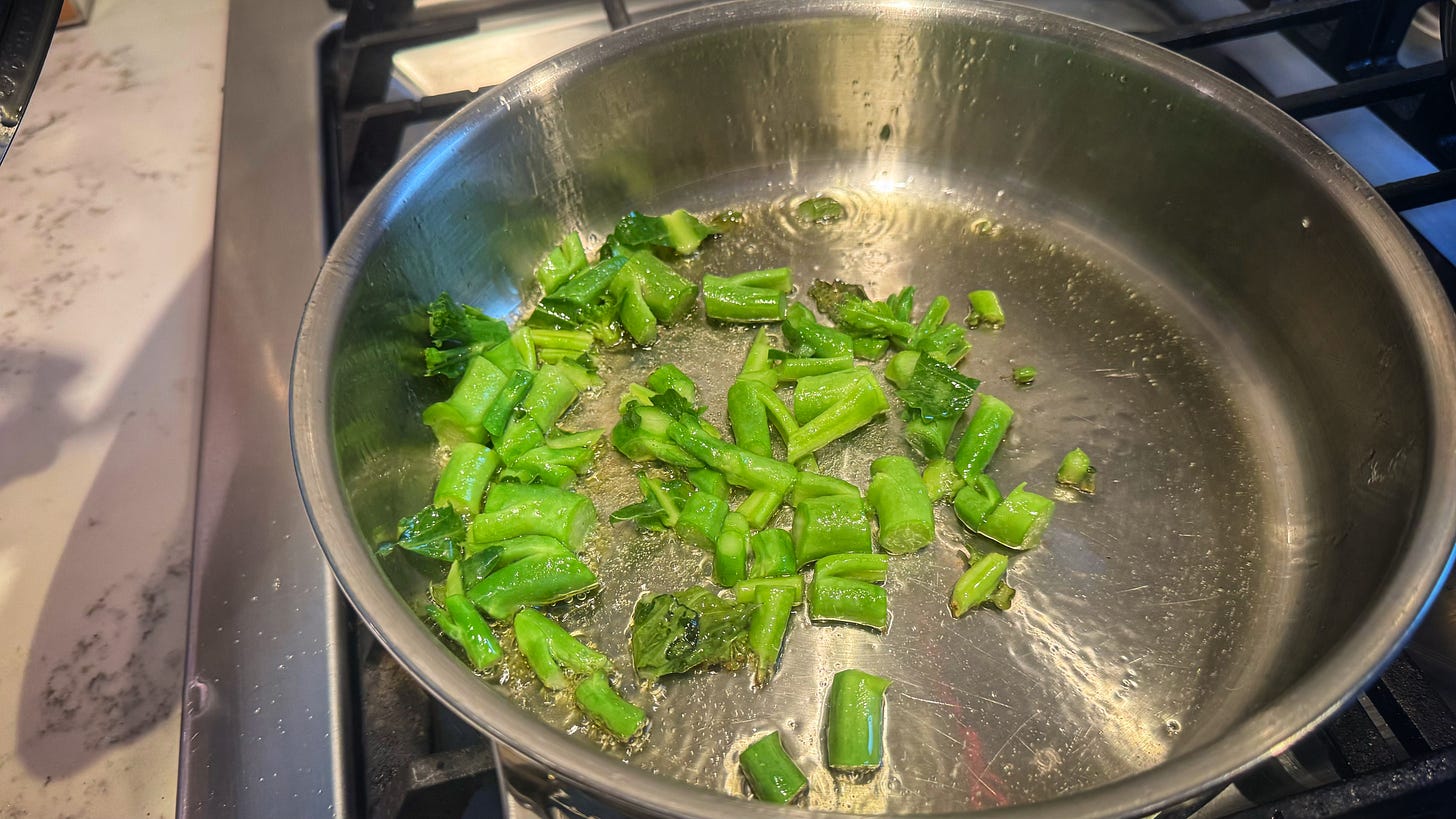59. My Gai
Do less, get more. Who can argue with that?
Before we get to the newsletter proper, I wanted to let you know that The Plate Cleaner on Video is back with another episode, this time about the Japanese Canadian Chow Mein I wrote about back in January 2021.
Before I started making videos, I didn’t realize a) how time-consuming it can be and b) how much people commenting, liking, and subscribing to my channel increases its visibility to other people who don’t know about The Plate Cleaner. So if you can find a way to do any of those things, I’d really appreciate it.
OK, now on to the newsletter.
I have met only one green I didn’t like: kale.1 Other than that, I like them all. Collards, mustard, rapini, turnip, chard, spinach, as well as Asian varieties like the various bok choys, mizuna, pea shoots, and my go-to, gai lan.


We almost always have gai lan in the fridge. Frozen dumplings or wonton (either store-bought or homemade), rice, and steamed or stir-fried gai lan with oyster sauce is a frequent, low-effort/easy-clean up weekday meal at our house. Chopped up gai lan tossed into the pot at the same time as the noodles adds a good chunk of the recommended dietary allowance for folates and Vitamins A, C, and K, offsetting, perhaps, the hit to your sodium RDA that the noodles and soup deliver. The gai lan goma-ae (cold gai lan dressed in sesame, miso, and sake) at Imanishi Japanese Kitchen is also fantastic.
Until recently, I had only ever used Asian greens as sides for other Asian dishes. I have no good reason why. It just never occurred to me.2 But recently I realized that I had forgotten to pick up the rapini I had planned to make for dinner alongside some pork chops and potatoes. I didn’t have time to pop out to a store that would carry it, but I did have a bunch of gai lan in the fridge. Cooked like rapini, I reasoned, it would be similar enough. I would use only garlic instead of garlic and ginger during the stir-frying and finish it with a squeeze of lemon and crushed red pepper flakes instead of oyster sauce.
To probably no one’s surprise but mine, it was terrific. Even better, it’s far cheaper than rapini. At Ample Food Market, our local Asian supermarket, gai lan sells for around $2.50 per pound (though I got it on sale last week for $1.59/lb). A package of Andy Boy rapini, the kind you’re most likely to find at the store, weighs about 300g and usually costs between four and five bucks, or between $6 and $7.50 per pound. In this economy?3 I’m bringing home a lot less rapini these days. Andy Boy is also imported from the US, which means I won’t be buying it for at least the next four years. Gai lan, by contrast, has been grown in and around Toronto since 1947.
While writing this week’s dinner plan, I took stock of what food we already had on hand and wanted to use up. There was some chicken breast, potatoes from the 10-pound sack I bought when it was the grocery store’s only Canadian potato option, breadcrumbs I made from the multigrain (ew) baguette I mistakenly bought at Christmas, and the rest of the gai lan I had bought on sale. I also had eggs, flour, and cream so… chicken schnitzel, mashed potatoes, and gai lan à la rapini. One dinner decided.
A lot of recipes for rapini have you blanch it briefly in a pot of boiling water before sautéing it to tame its strong bitterness. If I’m not boiling anything else, I’d rather not heat a whole pot of water for a 45-second dip. But without doing something to reduce the bitterness, it can definitely be too intense to be enjoyable. I prefer to cut rapini into bite-sized pieces, wash them thoroughly in a colander, and then leave them to drain but trying to keep as much water clinging to the leaves as possible. I’ll heat some olive oil in a sauté pan and, when it’s shimmering, I will add the rapini (and its water) to the pan, followed immediately by salt, a bunch of minced garlic and a lid. In 2 or 3 minutes, the steam created has the same effect as blanching, while using far less time and energy and only dirtying a single pan. After that, the lid comes off, and I start sauteing the greens. Once they’re crisp-tender, I dress them with lemon or vinegar, pepper flakes, and maybe an additional shot of oil. Quick, easy, really tasty.
Gai lan stems are usually thicker than rapini stems, so for the schnitzel dinner, I separated the leaves from the stems, chopped the stems into smaller pieces, and let them steam in the pan for a few minutes before adding the leaves, garlic, salt, and lid.
When making greens this way, I usually give the lidded pan a few popcorn-style shakes during the steaming, just to make sure everything gets cooked equally. This time, I had other things on the go and let the steaming stems alone until it was time to add everything else. What resulted wasn’t done on purpose, but I will definitely be doing it next time.
The sides of the stem chunks that had been face down in the pan had turned a deep, delicious brown that added another layer of flavour to an already flavourful dish. Whatever style of dish I’m making next time, I am definitely adding the stems first and the leaving them undisturbed to brown for a few minutes.
Isn’t it great to learn a new way to turn less (work, effort, attention) into more (flavour)?
What’s on the menu…
A succulent Chinese meal. We had friends over for dinner on the weekend and I decided to serve a few of the dishes I’ve become handy with over the last few years, including Hong Kong-style Noodles from MadewithLau.com, and Sue Li’s incredible Chili Oil Wontons from the New York Times’ recent Dumpling Week special. And a decidedly non-Chinese but equally delicious (and very simple to prepare) Lemon Posset for dessert.
There are both soup and sandwiches on the dinner plan this week, so I decided to make a batch of Joe Rosenthal’s hoagie rolls instead of buying bread. According to the photos on my phone, I haven’t made them since 2022. They were very oddly shaped. I’m hoping that the intervening years and lots of pizza dough making practice will help get better results this time. I will report back.
What I’m consuming…
After finishing Griffin Dunne’s The Friday Afternoon Club: A Family Memoir, I was still in a memoir mood, so I’ve just started The Sweet Life in Paris: Delicious Adventures in the World's Most Glorious—and Perplexing—City, David Lebovitz’s memoir about packing up his life in northern California and moving Paris to start anew. I’m only a few chapters in, but the combination of food, Paris, and memoir is very relevant to my interests. In addition to being a terrific writer (check out his newsletter) Lebovitz was also, prior to the move, the pastry chef at Chez Panisse, so he knows of what he writes.
I’m writing this on the day it was announced that Gene Hackman, his wife, and their dog were found dead in their New Mexico home. It’s incredibly sad news with so many unanswered questions. Of the many great clips from the many great movies in his filmography being shared shared today, this one was a much-needed laugh.
I know. not liking kale is a cliché at this point, but I can’t stand it and can’t be bothered to expend the time and effort required to make it palatable.
And I find that embarrassing. For all the different things I try in the kitchen, overlooking something as basic as using a green vegetable like any other green vegetable is such a dumb miss.
My mother-in-law (Hi Mike!) figured this out years before I did, when inflation was at its worst, substituting bok choy for lettuce in her salads.







Bizarrely I can find Gai lan easier than rapini here in Madrid. I wonder if Gai Lan is easy to grow in the garden?
I’ve recently been using Bok Choy in ways and recipes I normally wouldn’t, including salads and slaws. It’s been a bit of a revelation.